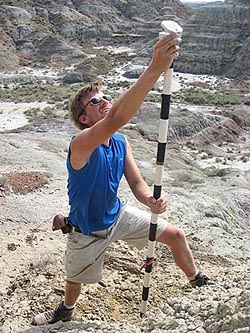
Eric Lynch ('10) conducted field work in Montana this summer, and is spending this fall in the lab using scanning electron microscopy, confocal laser scanning microscopy and imaging MALDI-mass spectrometry to image and analyze soft-tissue structures isolated from Upper Cretaceous dinosaur fossils.
In the photo to the left, Eric is measuring a stratigraphic section and collecting sedimentary data at the Thescelosaurus site, above and below the bone layer to put the dinosaur into a paleoenvironmental context.
Eric's advisors are Drs. Jeff Trop and Chris Daniel. Eric received competitive grants from the Evolving Earth Foundation and the Geological Society of America.
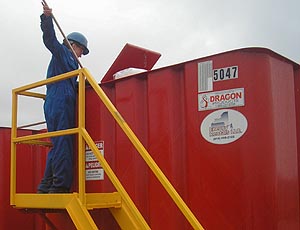
Molly Pritz ('10) is interested in understanding the potential environmental hazards resulting from the mixing of oil field brines and "Frac Water" when drilling companies hydraulically fracture and extract natural gas from in the Marcellus Shale.
Molly sampled and analyzed the end-stage drilling fluid from several wells and is performing geochemical modeling to understand the reactivity and the treatment needs of the oil field brines and the frac water. In addition, this study can help provide insight to potential stream degradation and aquifer contamination which may ensue from hydraulic fracturing and natural gas extraction techniques.
In the photo above, Molly is sampling the Frac Water product from one of her study sites.
Molly's advisor is Dr. Carl Kirby. She received funding through the McKenna Summer Environmental Internship Program at Bucknell.
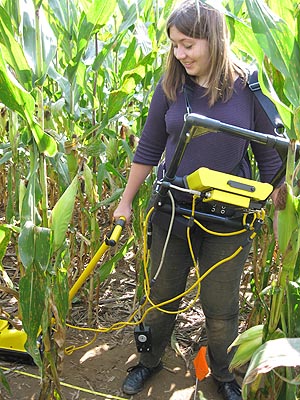
Bucknell is fortunate to have a large alluvial aquifer and wetland system available for study directly across the Susquehanna River, and Anne Strader ('10) is working with her advisor, Dr. Rob Jacob to analyze the water table location in the Montandon gravel ridge.
Anne is using seismic, DC resistivity and ground-penetrating radar in order to determine the water table location and analyze the moisture gradient in the unsaturated zone. She is hoping for some changes in the local weather so she can look for fluctuations due to seasonal variation and individual rainstorm events.
In the photo to the right, Anne is working her way through the corn while conducting a ground-penetrating radar survey on the gravel ridge.
For 10 weeks in the mid-late summer, Anne participated in the 2009 IRIS Undergraduate Internship Program, contributing research to the PLUME (Plume-Lithosphere-Undersea-Melt-Experiment) project at Scripps Institute of Oceanography. She analyzed earthquake data from both land and ocean bottom seismometers to perform "a tomographic inversion of the Hawaiian Island Chain subsurface", lending support to the interpretation that magma plumes may have caused the volcanism that formed the Hawaiian Island chain. Anne will present her findings at the 2009 American Geophysical Union fall meeting. You can read more about Anne's research at her IRIS Intern blog.
Bucknell Geology Independent Student Research Projects, 2009-2010
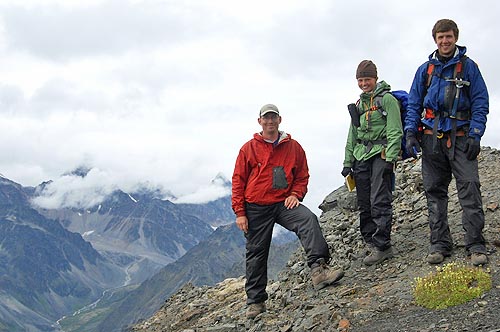
Cullen Kortyna ('11) spent his second consecutive summer conducting sedimentological field work in the Talkeetna Mountains, in southern Alaska. This summer's field work was aimed towards a integrated sedimentologic and geochronologic analysis of the Arkose Ridge Formation.
Cullen received a competitive grant from the Geological Society of America, and also received support from the Bucknell Program for Undergraduate Research and the National Science Foundation. Cullen recently presented some results of his work from the past two summers at the GSA National Meeting in Portland, Oregon.
The photo above shows Cullen (right) in the Talkeetna Mountains, along with Christine Kassab ('09 - and currently a graduate student at Purdue University) and Dr. Jeff Trop, his advisor. Their mapping and measured stratigraphic sections provide improved reconstruction of Paleogene paleoenvironments and constraints on the displacement history of the Castle Mountain fault.
Cullen also spent part of his summer at field camp.
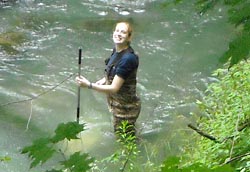
Amy Jewett ('11) worked with Dr. Ellen Herman much of the summer to understand the impacts of storms and sediments on the development of karst (cave) environments.
They chose a a system of two karst sinks near Smullton, PA and monitored temperature, pressure, turbidity, pH, conductivity, and took both suspended and bedload sediment samples during storm events to study the impact of sediments and abrasion on the development of a conduit (co-authored presentation at the National GSA meeting).
Amy was funded by the McKenna Summer Environmental Internship Program and is currently spending a year in Germany as part of the Bucknell Study Abroad Program.
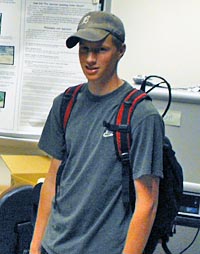
Luke Swensen ('11) is also interested in the potential environmental effects resulting from the natural gas drilling in the Marcellus Shale, and is working with Dr. Carl Kirby to determine the feasibility and effectiveness of using conductivity meters as an economical way to detect the runoff of "frac water" used in the horizontall drilling method.
He is accomplishing this by analyzing discharge and specific conductance from presumably uncontaminated streams, and comparing it to data collected on a stream which is more likely to be affected by drilling.
Luke was funded by the Bucknell University Environmental Center.
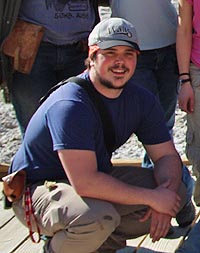
Jeremy Byler ('12) is a Geology/Civil Engineering double-major at Bucknell, and spent a majority of the summer working at the Montandon Long-Term Hydrologic Research site with Dr. Rob Jacob.
The depth to bedrock in this area has been studied previously, but Jeremy is revisiting the site using seismic and DC resistivity to provide a better understanding of the depth to bedrock between the Montandon Marsh and the Susquehanna River, and to map the interface between western boundary of the wetland and adjacent gravel ridge.
Jeremy was funded by Bucknell Program for Undergraduate Research.
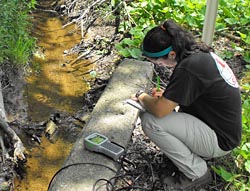
Sherry Finkel ('10) and her advisor Dr. Carl Kirby are analyzing the geochemical properties of headwater streams to understand if they have been impaired by acid deposition.
Sherry is focusing her work on streams emanating from the Allegheny and Pottsville geologic formations, and is using Geographic Information Systems (GIS) and geochemical analysis to help solve the problem. The PA Department of Environmental Protection has designated many of these streams as either "attaining" or unimpaired, while Dr. Kirby and others have suggested that they are actually impaired by acid deposition. Sherry is using alkalinity, pH, and metal composition measurements at several sites across central and western Pennsylvania to gain a better understanding of the geologic and anthropogenic influences on these streams.
Sherry was funded by the McKenna Environmental Internship Program for her research over the summer.